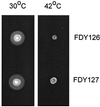Effects of lipoprotein biogenesis mutations on flagellar assembly in Salmonella
- PMID: 11790747
- PMCID: PMC139530
- DOI: 10.1128/JB.184.3.771-776.2002
Effects of lipoprotein biogenesis mutations on flagellar assembly in Salmonella
Abstract
Flagellar assembly requires the expression of a large number of flagellum-specific genes. However, mutations in a number of other genes in Salmonella and Escherichia coli have been shown to have pleiotropic effects that affect flagellar assembly. FlgH (the L-ring subunit of the flagellar basal body) is a lipoprotein whose modification is important for L-ring assembly. We therefore tested whether the lack of motility of Salmonella mutants defective in lipoprotein biogenesis is a result of inability to modify FlgH. Our results show that temperature-sensitive apolipoprotein N-acyltransferase [lnt(Ts)] mutants are nonflagellate at 42 degrees C. However, the flagellar assembly defect occurs at a much earlier step in the pathway than L-ring assembly. These mutants failed to assemble even an MS ring, presumably because of the observed decrease in transcription of fliF. In contrast, temperature-sensitive diacylglycerol transferase [lgt(Ts)] mutants were motile at 42 degrees C, provided the strains carried an lpp (Braun lipoprotein) mutation to permit growth. We have isolated second-site mutants from an lgt(Ts) lpp(+) strain that grow but are nonflagellate at 42 degrees C. Thus, lipoprotein biogenesis is a factor that is important for flagellar assembly.
Figures





Similar articles
-
Flagellar assembly in Salmonella typhimurium: analysis with temperature-sensitive mutants.J Bacteriol. 1990 Mar;172(3):1327-39. doi: 10.1128/jb.172.3.1327-1339.1990. J Bacteriol. 1990. PMID: 2407720 Free PMC article.
-
Intergenic suppression between the flagellar MS ring protein FliF of Salmonella and FlhA, a membrane component of its export apparatus.J Bacteriol. 2001 Mar;183(5):1655-62. doi: 10.1128/JB.183.5.1655-1662.2001. J Bacteriol. 2001. PMID: 11160096 Free PMC article.
-
Physiological and biochemical analyses of FlgH, a lipoprotein forming the outer membrane L ring of the flagellar basal body of Salmonella typhimurium.J Bacteriol. 1996 Jul;178(14):4200-7. doi: 10.1128/jb.178.14.4200-4207.1996. J Bacteriol. 1996. PMID: 8763949 Free PMC article.
-
The flk gene of Salmonella typhimurium couples flagellar P- and L-ring assembly to flagellar morphogenesis.J Bacteriol. 1997 Apr;179(7):2389-400. doi: 10.1128/jb.179.7.2389-2400.1997. J Bacteriol. 1997. PMID: 9079927 Free PMC article.
-
Flagellar assembly in Salmonella typhimurium.Mol Microbiol. 1996 Jan;19(1):1-5. doi: 10.1046/j.1365-2958.1996.344874.x. Mol Microbiol. 1996. PMID: 8821931 Review.
Cited by
-
Environmental transcriptome analysis reveals physiological differences between biofilm and planktonic modes of life of the iron oxidizing bacteria Leptospirillum spp. in their natural microbial community.BMC Genomics. 2010 Jun 24;11:404. doi: 10.1186/1471-2164-11-404. BMC Genomics. 2010. PMID: 20576116 Free PMC article.
-
Transcriptional Responses of Escherichia coli to a Small-Molecule Inhibitor of LolCDE, an Essential Component of the Lipoprotein Transport Pathway.J Bacteriol. 2016 Nov 4;198(23):3162-3175. doi: 10.1128/JB.00502-16. Print 2016 Dec 1. J Bacteriol. 2016. PMID: 27645386 Free PMC article.
-
The two murein lipoproteins of Salmonella enterica serovar Typhimurium contribute to the virulence of the organism.Infect Immun. 2004 Jul;72(7):3987-4003. doi: 10.1128/IAI.72.7.3987-4003.2004. Infect Immun. 2004. PMID: 15213144 Free PMC article.
-
Murein lipoprotein is a critical outer membrane component involved in Salmonella enterica serovar typhimurium systemic infection.Infect Immun. 2005 Feb;73(2):1081-96. doi: 10.1128/IAI.73.2.1081-1096.2005. Infect Immun. 2005. PMID: 15664952 Free PMC article.
-
Direct visualization of red fluorescent lipoproteins indicates conservation of the membrane sorting rules in the family Enterobacteriaceae.J Bacteriol. 2006 May;188(10):3516-24. doi: 10.1128/JB.188.10.3516-3524.2006. J Bacteriol. 2006. PMID: 16672606 Free PMC article.
References
Publication types
MeSH terms
Substances
Grants and funding
LinkOut - more resources
Full Text Sources

